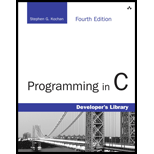
Concept explainers
Type in and run the five programs presented in this chapter. Compare the output produced by each
Data types:
The variables use data-type during their declaration.
- The data-type is used to determine the size of memory allocated. Here, the compiler allots the memory.
- All data-type needs different size of memory.
Some of the data-types are:
- Integer
- Boolean
- Character
- Double
- Floating point
Integer data type:
The “int” is a keyword for floating point datatype.
It is a number and it cannot have a fractional part. It may be a positive value, a negative value or zero.
- Integer data type uses 4 bytes of memory.
Boolean data type:
The “_Bool” is a keyword for floating point datatype.
- A Boolean data type is a data type that represents the two values.
- The two values are “true” and “false”.
Character data type:
A “char” is a keyword for character data type.
- Character data type stores the characters.
- Character data type requires one byte memory space.
- The character should always place inside the single quotes.
Double data type:
The “double” is a keyword for floating point datatype.
The size of the double variable contains 8 bytes.
It can represent real numbers, minus and decimal numbers.
Floating point data type:
The “float” is a keyword for floating point datatype.
- The data type “float” stores single precision floating point decimal values.
- The memory space used for float is “four” bytes.
Explanation of Solution
Program:
Consider the five programs presented in the given chapter.
Program 3.1:
//include the header file
#include <stdio.h>
//definition of main method
int main (void)
{
/*declare and initialize the value to the required variables*/
int integerVar = 100;
float floatingVar = 331.79;
double doubleVar = 8.44e+11;
char charVar = 'W';
_Bool boolVar = 0;
//display the result
printf ("integerVar = %i\n", integerVar);
printf ("floatingVar = %f\n", floatingVar);
printf ("doubleVar = %e\n", doubleVar);
printf ("doubleVar = %g\n", integerVar);
printf ("charVar = %c\n", charVar);
printf ("boolVar = %i\n", boolVar);
//return statement
return 0;
}
Explanation:
In the above program, declare the variables with different data types and assign values to that variables. Then display the values using “printf” function on the output screen.
Sample Output for program 3.1:
integerVar = 100
floatingVar = 331.790009
doubleVar = 8.440000e+11
doubleVar = 8.44e+11
charVar = W
boolVar = 0
Want to see more full solutions like this?
Additional Engineering Textbook Solutions
Starting Out with C++: Early Objects
Computer Science: An Overview (12th Edition)
Modern Database Management
Java: An Introduction to Problem Solving and Programming (8th Edition)
Database Concepts (7th Edition)
Web Development and Design Foundations with HTML5 (8th Edition)
- (Desk check) Determine the output produced by the following program: includeiostreamusingnamespacestd;intmain()inti,j,val[3][4]={8,16,9,52,3,15,27,6,14,25,2,10};for( i=0;i3;++i)for( j=0;j4;++j)coutval[i][j];return0;arrow_forwardWrite the programmearrow_forwardPlease follow all the steps in detail. Follow the desired output of the program as shown below.arrow_forward
- Provided the codes used to run this programarrow_forwardCreate a truth table that corresponds to the combinational function listed below. 1) F(X, Y, Z) is true when exactly one of the following is true: a) X is true b) Y is false and Z is truearrow_forwardSolve the part d in accordance with the program given make whatever changes or omissions are required paste the screenshot of program and outputarrow_forward
 C++ for Engineers and ScientistsComputer ScienceISBN:9781133187844Author:Bronson, Gary J.Publisher:Course Technology Ptr
C++ for Engineers and ScientistsComputer ScienceISBN:9781133187844Author:Bronson, Gary J.Publisher:Course Technology Ptr C++ Programming: From Problem Analysis to Program...Computer ScienceISBN:9781337102087Author:D. S. MalikPublisher:Cengage Learning
C++ Programming: From Problem Analysis to Program...Computer ScienceISBN:9781337102087Author:D. S. MalikPublisher:Cengage Learning

